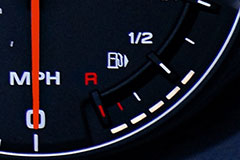What Is the Arrow Symbol on the Fuel Indicator For? - Vol.401
Can you imagine yourself getting out of your new car, opening the fuel tank and inserting a dipstick inside to determine how much fuel you have left? This might seem like a complete nonsense but it was actually the only way for the first drivers to get this kind of information. Early cars did not have windows and rooftops, let alone any instruments, and what we today take for granted was actually very modern equipment back in the day.

The Fuel Gauge
In the early decades of the twentieth century, car manufacturers started introducing innovative gadgets such as speed-o-meters and fuel gauges. The first fuel gauges were fitted directly on fuel tanks. It wasn't until 1914 that Studebaker manufactured the first car model with a fuel indicator mounted on the dashboard. At first, these were mainly mechanical instruments, but later electricity took over and we never looked back since.
Today, fuel gauges are common and necessary in all types of vehicles. The fuel indicator is probably the most carefully observed segment on the dashboard. Aside from the super famous "F"(full) and "E" (empty) marks, one more mark is commonly found on fuel indicators all around the world. The fuel dispenser mark, a graphical depiction of a fuel pumping machine used to supply our cars with gasoline.
At first glance, this appears to be logical. The fuel dispenser mark is there to inform you that you should check all the relevant, fuel-related information by looking in its direction. Recently, the information that this was not the only function of the little symbol has interested the wider public.
The Mysterious Symbol
What happened is that car manufacturers started adding an arrow (or triangle) symbol next to the fuel dispenser mark. Many drivers did not notice such a small change but those who did started wondering about its purpose. It turned out that the tip of the arrow points out the side of the vehicle on which the fuel tank is located.
To some drivers this did not come as a surprise. They already knew it or guessed it. What was even more surprising is that on older car models the position of the fuel dispenser's hose or of the fuel dispenser mark itself (left or right) had the same purpose but was ineffective. So it was replaced with the more obvious arrow.
The real question remains, how useful this really is? Many people would ask themselves if it is possible that someone does not know where the fuel tank on their car is. In some cases, it is both useful and possible.
In certain circumstances, the little arrow can play a more important part. Let's say that you have rented or borrowed a car and you are in need of a fuel refill. You are heading towards the gas station and suddenly, you realize that you do not know where the lid of the fuel tank is positioned on the car you are driving. How will you know on which side of the fuel dispenser to park?
This takes us back to the beginning of this story. You can always do what that diligent early driver would do. That is, stop and leave the car and look for your fuel tank. But why do that when you can use the little arrow symbol that was put on your dashboard by the kind people of the car manufacturing industry, and enjoy the merits of the modern age in the process?